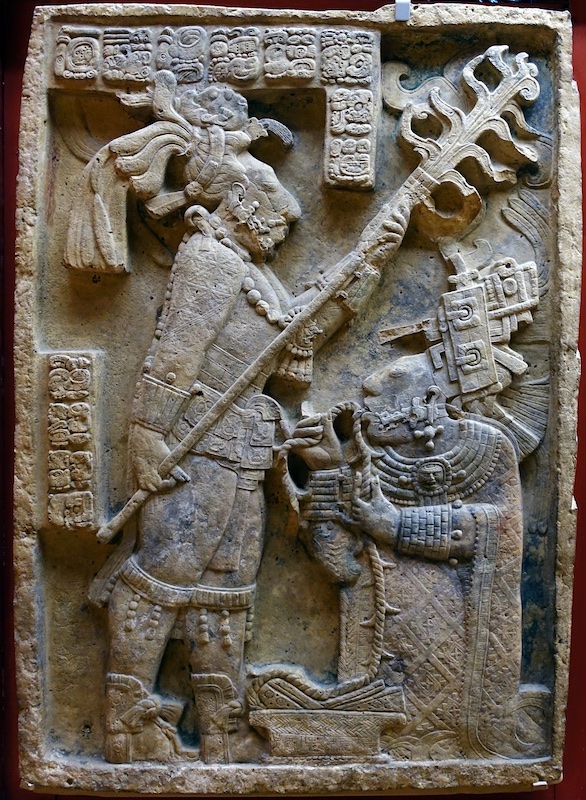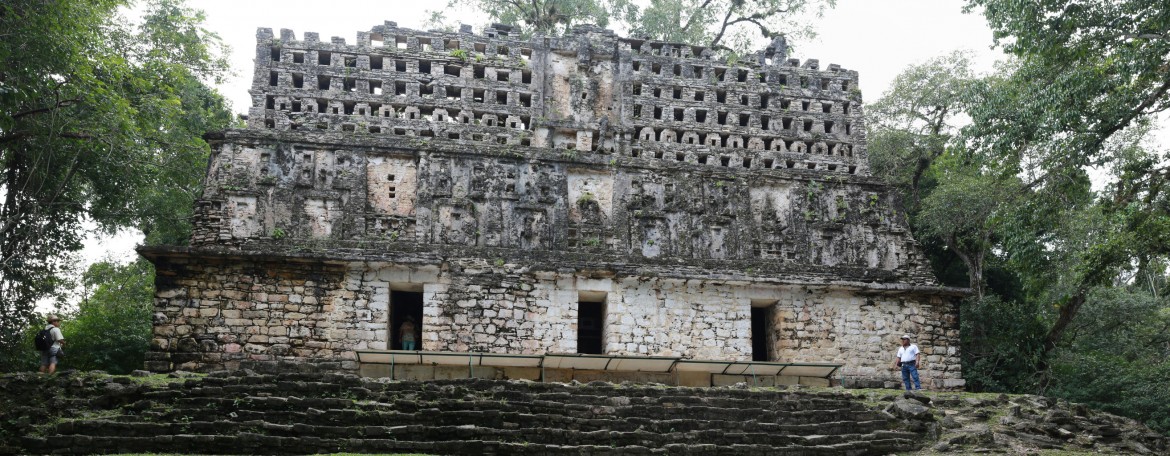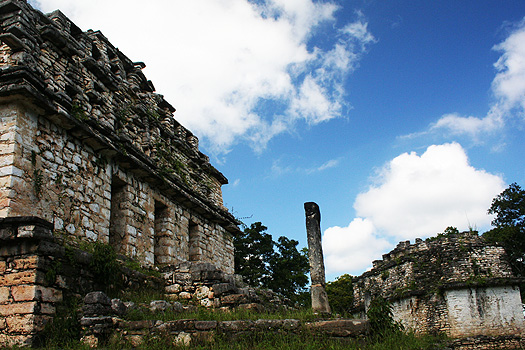Yaxchilán
Chiapas, Mexico. Maya. 725 C.E. Limestone (architectural complex)
Yaxchilán is located on the south bank of the Usumacinta River, in Chiapas, Mexico. It was a significant Maya center during the Classic period (250-900 C.E.) and a number of its buildings stand to this day. Many of the exteriors had elaborate decorations, but it is the carved stone lintels above their doorways which have made this site famous. These lintels, commissioned by the rulers of the city, provide a lengthy dynastic record in both text and image.
Yaxchilán located in Chiapas, Mexico
What is the geography of the area, and how does it shape its art?
The geography of this near Usumacinta River and Piedras Negras as its major rival. It is believed that they built it where is was to show dominance and strength towards their rivals. The architectural styles show a huge contrast to their rivals: shows the huge differences between the two kingdoms (may have been on purpose or lack of communication). There is a loop defends the site on all sides except for a narrow land approach from the south on the river.
Content:
The site is host to an impressive number of structures and monuments (over 100)
Famous for its high-quality relief carvings.
Carved lintels (the beam at the top of a doorway)
Stairs have hieroglyphic writing and stele (upright wood or stone slab monuments)
Structure 23 (most famous lintels): a toot (palace building) and shows Shield Jaguar II’s wife (Lady K’abal Xook)
(The three lintels on Structure 23)= 24, 25, and 26
depict different ritual moments in the life of Lady Xook showing a narrative
Lintel 24: Lady Xook pulls a thorned cord through her tongue so that she can bleed onto paper that fills a basket on the ground before her which is called bloodletting
Her husband (Shield Jaguar II) holds a lit torch above her
beautiful diamond pattern decorates Lady Xook’s huipil
Lintel 25: from the central doorway also bloodletting ritual carried out by Lady Xook kneels before a vision serpent, from whose mouth emerges a figure.
She holds bowl in her left hand as she looks up towards rising serpent addition, she has on headdress, elaborate bracelets, earrings, and a necklace (jade)
In the bowl are pieces of paper stained with her blood.
Figure emerging from the vision serpent’s mouth has a shield, spear and a war helmet; (like Lady Took) has elaborate headdress, a breastplate and ear spools
A glyphic inscription (written backwards) in the upper left corner: the date of Shield Jaguar II’s ascension to the throne in October 681
All scenes are carved with great precision and detail decorating the raised surfaces
The Yaxchilán lintels: were painted but only traces are seen now: red on Lady Xook’s clothing and Maya blue color on the background of Lintel 24
Structure 33
three entryways in the exterior
Decorated with stucco ornamentation
The top step of Structure 33 displays rulers, including Bird Jaguar IV and his father and grandfather playing the ballgame in a series of thirteen carved limestone blocks: They play against Yaxchilán enemies—such as Lord Jeweled Skull who Bird Jaguar defeats
Elaborate roof-comb= a masonry “wall” that rises upwards above a building to give the impression that it is taller than it actually is
- has a decorative frieze, niches, and sculptural elements (sculpted human being in the central niche)
- Lintel 1: Bird Jaguar festooned in the fantastic clothing of a Maya ruler
- Lintel 2: Bird Jaguar and his son and heir, Chel Te’ Chan K’inich
Structure 40:
-unusual concept of ideal beauty
-often had a chacmool (half sitting half lying down figure, head turned 90 degrees)
Function:
Relief sculptures: (Lintel 45 on Structure 44) show Shield Jaguar II with war captives to commemorate his victory in battles against rival city-states
Reinforce the reign of the ruler and his dynastic ties and wife
Structure 33: built by Bird Jaguar IV, (like a father to Shield Jaguar II) ordered series of building projects and monuments= to legitimate his rule, insist respect, and show power.
Structure 33:
placed on the side of the main plaza= making it a focal point for the area and to attract attention of the people
The building is narrow: only able to hold a small amount of people: for royalty or elites
To show the people their difference in status (lower)
Focus on Lady Xook: the ruler wanted to promote his lineage and power through his most important wife (who had more prestige than his other wives)
important for showing Shield Jaguar II’s power
important role of royal women in Maya culture
Context:
Yaxchilán’s dynasty 4th century C.E:
Lord Shield Jaguar II who ruled for 60 years beginning in 681
He commissioned famous sculptural works at the site
Bird Jaguar IV (heir) followed his father: built buildings and sculptures were created before the city-state collapsed in the 9th century
Prior Structure 23: gap/halt in building at Yaxchilán for about 150 years
Lintels (not when they were built) but when they were excavated
Bloodletting was a common ritual among elites
Very common in depiction of Mayan art
Ruler, elites (including women): would let blood to honor and feed the gods= ceremony of a building, children were born, or special occasions
Rulers needed to shed blood in order to maintain order in the cosmos
Rulers were believed to be a descendent of the gods & bloodletting was important for maintaining power and order in the community
Bloodletting was act related to rebirth and rejuvenation.
-The loss of blood and the burning of incense produced hallucinations: to access other realms.
- Lady Took burned the paper to allow the blood to ascend to the gods attract the vision serpent.
- Structure 33: Maya Classic architecture
Form:
-Yaxchilán’s central complex of buildings (called the Central Acropolis)
-The contour and incised lines of the lintels possess a calligraphic quality, as if they were drawn or painted rather than carved.
- Great attention to detail, sophistication, formal: other mayan cultures in vaes and murals
-Many of the exteriors had elaborate decorations,
- the carved stone lintels above their doorways which have made this site famous
-lintels: provide a lengthy dynastic record in both text and image.
include carved lintels (the beam at the top of a doorway), stairs faced with hieroglyphic writing, and stele (upright wood or stone slab monuments).
- Structure 23: a yotoot (palace building) showing Shield Jaguar II’s wife, Lady K’abal Xook -underneath it are the limestone lintels when entering the doorway
Themes:
Power
Authority
Femininity
Royalty
Elite
Lineage
Gender roles
Respect
Worship
Spirituality
Beauty
Dominance
Strength in war
Cross Cultural:
1. Apollo 11 stones
167. Conical tower and circular wall of Great Zimbabwe
214. Moai on platform (ahu)



